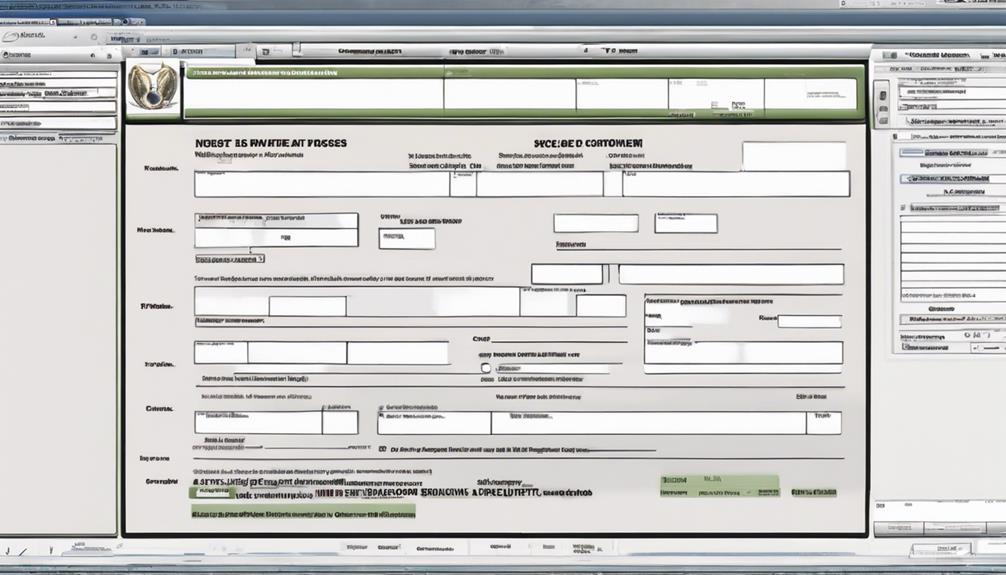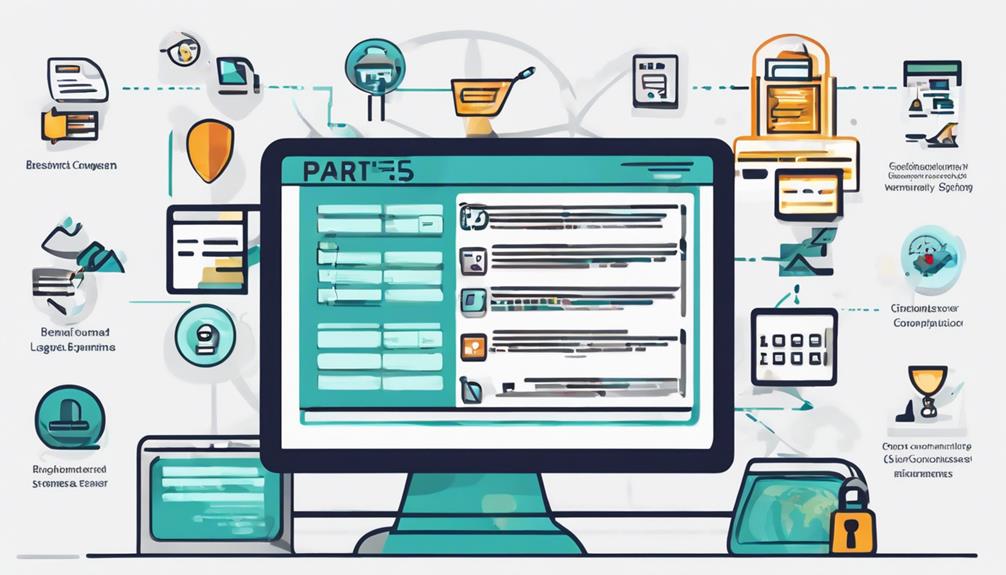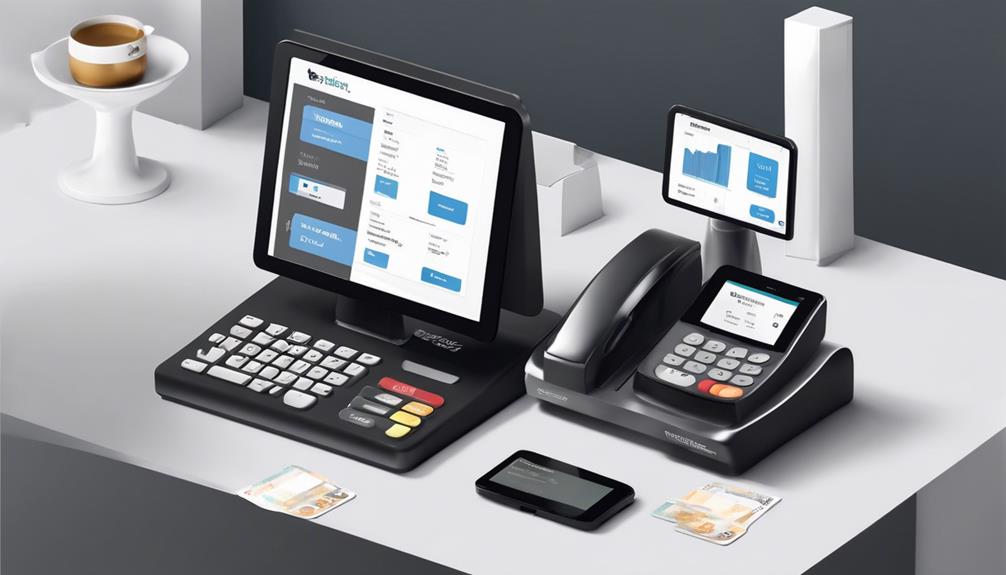Start your small business on the path to seamless online payment processing with the following steps. Start by exploring different third-party software options to compare features, evaluate capabilities, and prioritize PCI DSS compliance. Next, set up a merchant account by choosing a payment processor, inputting accurate information, and integrating a secure payment gateway. Make sure to include account details on invoices to streamline payment collection and enhance transparency. Implement click-to-pay services on your website to expedite payments and ensure security. Seek guidance from financial experts for recommendations on secure integration and compliance.
Implement various online payment methods, offer clients more options, ensure regulatory compliance, and utilize robust reporting tools for informed decision-making. These steps will pave the way for efficient and secure digital transactions, setting your small business up for success.
Key Takeaways
- Research and select a reliable payment processor for secure transactions.
- Create a merchant account with accurate business details for approval.
- Attach account information to invoices for streamlined payment collection.
- Provide click-to-pay services on the website for client convenience.
- Ensure compliance with regulations, prioritize security, and offer various payment options.
Researching Third-Party Software Options
When researching third-party online payment software options, compare features and pricing structures to find the best fit for your business needs. It's crucial to assess the capabilities of different third-party software providers in terms of online payment processing.
Look into the pricing structures they offer, including transaction fees that could impact your bottom line. Integrated solutions are also key, ensuring seamless compatibility with your existing website or business platform.
Customer support is essential; consider the availability and quality of support services provided by each software option. Additionally, prioritize software that's PCI DSS compliant to safeguard sensitive payment data.
User reviews can offer valuable insights into the ease of use and overall satisfaction with the software. Making an informed decision based on these factors will set your business up for efficient and secure online payment processing.
Creating a Merchant Account

When setting up a merchant account, we need to consider the account setup process, required documentation details, and verification and approval procedures.
This process entails gathering necessary business information, submitting it for review, and ensuring compliance with regulations.
Once all requirements are met, the account is typically approved, allowing businesses to start accepting online payments securely.
Account Setup Process
To establish a merchant account for online payment processing, businesses must submit an application to a payment processor or acquiring bank. Here are the key steps to set up a merchant account:
- Research and Choose: Select a reputable payment processor or acquiring bank that meets your small business needs.
- Application Submission: Fill out the required forms with accurate business details, banking information, and processing history.
- Review and Approval: Wait for the payment processor or acquiring bank to review your application and approve your merchant account.
- Integration: Integrate the secure payment gateway with your website or online platform to start accepting credit card payments.
Setting up a merchant account is crucial for small businesses to efficiently process online payments.
Required Documentation Details
Upon applying for a merchant account, businesses are required to provide specific documentation such as business registration details and tax identification numbers. Additionally, proof of address for the business, identification documents for the owner, and information about the products or services offered may be necessary.
Some providers might request financial statements, processing history, and business licenses to evaluate eligibility and risk. In certain cases, a credit check or background verification could be part of the process to ensure compliance with regulations.
Accurate and complete documentation is vital for a seamless merchant account approval and establishing secure online payment processing for your small business. Remember, thorough documentation is key to a successful online payment setup.
Verification and Approval
How do businesses navigate the process of verification and approval when creating a merchant account for online payment processing?
When setting up a merchant account, there are several key steps to consider:
- Provide accurate business details, including name, address, and tax ID, for verification.
- Undergo credit checks and underwriting as part of the approval process to assess risk.
- Be prepared for the verification and approval process, which can take a few days to a couple of weeks.
- Upon approval, gain access to payment processing services that enable securely accepting online payments.
Merchant accounts are crucial for securely facilitating credit and debit card transactions online.
Attaching Account Information to Invoices

When attaching account information to invoices, we secure online transactions and simplify payment collection for our clients. This method not only streamlines the payment process but also reduces the chances of errors or delays, promoting transparency and trust between our business and clients.
Secure Online Transactions
Ensuring secure online transactions involves attaching account information to invoices for direct payment processing. This method allows customers to conveniently pay directly to your designated account, enhancing transparency and reducing payment processing errors.
Here are some key benefits of securely attaching account details to invoices:
- Convenient Payment Process: Customers can easily make payments for products or services.
- Enhanced Transparency: Both businesses and customers benefit from a clear and traceable way of conducting online transactions.
- Reduced Errors: Securely attaching account information helps minimize payment processing mistakes.
- Streamlined Process: Direct payment processing through attached account details simplifies the payment process for all parties involved.
Simplify Payment Collection
To simplify payment collection, we attach account information to invoices for easy and secure transactions. By including bank details or payment links on invoices, small business owners can streamline the payment process for customers, providing clear payment instructions and enhancing the overall experience.
This method not only ensures quick and secure transactions but also helps businesses receive payments faster. With the assistance of a payment processing provider or payment gateway, businesses can seamlessly accept online payments, including credit card payments, by attaching the necessary payment information to invoices.
This approach offers convenience and efficiency, making it easier for customers to complete transactions and for small business owners to manage their finances effectively.
Providing Click-to-Pay Services on the Website

Integrating Click-to-Pay services on your website can significantly streamline payment collection and enhance cash flow for your small business. By offering this convenient payment method, you can simplify the payment process for your clients and ensure faster receipt of funds. Here are some key benefits of providing Click-to-Pay services on your website:
- Enhanced Client Experience: Clients can easily make payments by clicking a link in an email, offering them a seamless and user-friendly payment experience.
- Faster Payment Processing: Click-to-Pay services expedite the payment process, allowing you to receive funds more quickly and improve your cash flow.
- Ideal for Online Invoices: These services are particularly useful for accepting online invoice payments, making it convenient for clients to settle their bills.
- Secure Payment Transactions: Clients can securely submit payments with just a click, ensuring the safety of their financial information while providing them with payment flexibility.
Seeking Guidance From Financial Professionals

Financial professionals play a key role in guiding small businesses towards optimal online payment processing solutions. When it comes to setting up online payments, seeking guidance from these experts can be invaluable. They can provide essential advice on selecting the right payment processor and merchant account tailored to your business requirements.
Additionally, financial professionals can offer insights on securely integrating payment systems into your website or mobile app, ensuring a seamless user experience.
Moreover, these professionals can help you navigate the cost implications and regulatory requirements associated with online payment processing. By consulting with financial experts, you can ensure that your online payment process isn't only efficient and secure but also compliant with industry standards. Their expertise can help you make informed decisions that will benefit your small business in the long run.
Trusting in the guidance of financial professionals is a proactive step towards optimizing your online payment methods.
Implementing Online Payment Methods

When considering online payment methods for our small business, prioritizing customer convenience and security is paramount. Here are some essential steps to implement various online payment methods effectively:
- Integrate a Secure Payment Gateway: Ensure seamless and secure online transactions by incorporating a reliable payment gateway on your website.
- Accept eCheck Payments: Lower processing fees by allowing customers to make direct transfers using eChecks, providing a cost-effective alternative to credit cards.
- Explore Mobile Payment Options: Embrace mobile payment solutions like mobile card readers or click-to-pay email invoicing for both in-person and remote transactions, offering flexibility and speed.
- Enable Automatic Bill Payments: Simplify the payment process for clients and improve cash flow by setting up automatic bill payments, ensuring timely payments and reducing administrative tasks.
Offering Clients More Payment Options

Embracing diverse payment methods enhances customer satisfaction and boosts sales for small businesses. By offering clients more payment options, businesses can cater to a wider range of preferences, leading to increased customer satisfaction and loyalty. Providing flexible payment options not only reduces cart abandonment rates but also encourages repeat customers, ultimately driving growth and revenue. Small businesses that offer various payment choices have seen significant improvements in key metrics such as average transaction value and customer retention.
| Benefits of Offering More Payment Options |
|---|
| – Up to 30% increase in sales |
| – 40% boost in customer satisfaction |
| – 20% reduction in cart abandonment rates |
| – 60% increase in average transaction value |
| – 25% growth in repeat customers |
Ensuring Compliance With Regulations

To ensure smooth operations and protect customer data, small businesses must adhere strictly to regulatory guidelines for online payment processing. Compliance with PCI DSS standards and other regulatory requirements is crucial for maintaining a secure online payment processing system. Here are key steps to ensure regulatory compliance:
- Implement Data Protection Measures: Safeguard sensitive customer information by implementing encryption, tokenization, and other security measures to protect data both at rest and in transit.
- Regularly Update Security Protocols: Stay ahead of evolving cyber threats by regularly updating security protocols and software within your online payment processing system.
- Seek Professional Guidance: Navigate complex regulatory requirements and ensure adherence to industry standards by seeking advice from legal and financial professionals with expertise in online payment processing.
- Understand Legal Implications: Comprehend local and international regulations governing online payment processing to avoid legal issues and maintain compliance with industry standards.
Utilizing Robust Reporting Tools

As we ensure compliance with regulations, leveraging robust reporting tools becomes pivotal in gaining detailed insights into payment transactions and customer behaviors. Small businesses rely on these tools to track online payments, analyze revenue trends, and understand customer behaviors for effective financial management.
By utilizing reporting tools, businesses can generate customizable reports that provide in-depth information on payment methods used, sales performance, and customer demographics. Monitoring payment transactions through these tools allows for the identification of successful transactions, failed payments, and chargeback rates, enabling informed decision-making to optimize processes.
Additionally, reporting tools help in detecting potential fraud, improving security measures, and enhancing overall efficiency in payment processing. The transparency and accountability offered by these tools empower businesses to make data-driven decisions, ultimately leading to better financial management and increased control over online payment operations.
Frequently Asked Questions
How Do I Set up Online Payments for My Small Business?
Setting up online payments for our small business involves selecting a reputable payment processor, signing up for a merchant account, integrating the system into our website or app, ensuring PCI DSS compliance, and rigorously testing before going live.
What Are the Steps in Online Payment System?
We break down the steps in an online payment system: authentication confirms account details, authorization approves sales, and settlement ensures merchants get paid. Understanding these processes is vital for seamless online payment processing.
How Do I Set up Online Payment Processing?
To set up online payment processing, we research and choose a reliable payment processor, sign up for a merchant account, integrate payments securely, ensure PCI DSS compliance, and test the system before launch for a smooth customer experience.
What Are the Steps of Payment Processing?
Navigating payment processing is like sailing a ship through calm waters. We authenticate, authorize, and settle transactions efficiently. Understanding these steps ensures a smooth experience. Trust us to guide you through this process.
How can small businesses utilize online payment processing for platforms like Etsy?
Small businesses on Etsy can benefit from online payment processing to streamline transactions and reach a wider customer base. By utilizing Etsy payment processing fees, businesses can easily accept payments from customers and manage their finances efficiently, ultimately helping them grow and thrive in the competitive online marketplace.
Conclusion
In conclusion, implementing online payment processing for small businesses involves careful research, setting up merchant accounts, and providing multiple payment options for clients.
Seeking guidance from financial professionals and ensuring compliance with regulations are crucial steps in the process.
By utilizing robust reporting tools, businesses can track their transactions and optimize their payment systems for efficiency.
Taking the time to establish a secure and user-friendly online payment process can help small businesses streamline their operations and improve customer satisfaction.









